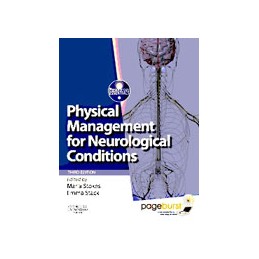- Obniżka


 Dostawa
Dostawa
Wybierz Paczkomat Inpost, Orlen Paczkę, DHL, DPD, Pocztę, email (dla ebooków). Kliknij po więcej
 Płatność
Płatność
Zapłać szybkim przelewem, kartą płatniczą lub za pobraniem. Kliknij po więcej szczegółów
 Zwroty
Zwroty
Jeżeli jesteś konsumentem możesz zwrócić towar w ciągu 14 dni*. Kliknij po więcej szczegółów
Printed book plus PageburstTM access - you will receive a printed book and access to the complete book content electronically. PageburstTM enhances learning by not only bringing world class content to your fingertips but also letting you add to it, annotate it, and categorize it all in a way that suits you. PageburstTM frees you to spend more time learning and less time searching.
The third edition of this popular textbook - formerly Physical Management in Neurological Rehabilitation and now renamed Physical Management for Neurological Conditions - maintains its scientific and research base with extensive use of references and case studies. It is the only book for physiotherapists that offers a comprehensive overview of the basic principles of neurological rehabilitation, specific neurological / neuromuscular conditions and the related physiotherapy treatment approaches used.
Important areas which feature throughout are discussed in relation to the different neurological conditions and include::
Opis
Preface Acknowledgments Abbreviations Contributors
Chapter 1: Rehabilitation in Practice: how this book can help you to help your patients Emma. Stack, Maria Stokes
SECTION 1 NEUROLOGICAL AND NEUROMUSCULAR CONDITIONS
Chapter 2: Stroke Geert Verheyden, Ann. Ashburn
Chapter 3: Acquired brain injury: trauma and pathology Maggie Campbell
Chapter 4: Spinal cord injury Sue Paddison, ,F iona Middleton
Chapter 5: Multiple sclerosis Lorraine H. DeSouza, David Bates
Chapter 6: Parkinsons disease Diana Jones, Jeremy Playfer
Chapter 7: Huntingtons disease Monica Busse-Morris, Lori Quinn, Oliver Quarrell
Chapter 8: Motor neurone disease Samantha Orridge, Emma Stebbings
Chapter 9: Polyneuropathies Gita Ramdharry
Chapter 10: Muscle Disorders Ros Quinlivan, Nicky Thompson
SECTION 2 TREATMENT APPROACHES IN NEUROLOGICAL REHABILITATION
Chapter 11: The theoretical basis for evidence-based neurological physiotherapy Sheila Lennon
Chapter 12: Specific treatment techniques Joanna Jackson
Chapter 13: Vestibular rehabilitation Dara Meldrum, Rory McConn Walsh
Chapter 14: Physical management of altered tone and movement Cherry Kilbride, Elizabeth Cassidy
Chapter 15: Respiratory management in neurological rehabilitation Anne Bruton
Chapter 16: Pain management in neurological rehabilitation Paul Watson
Chapter 17: Clinical neuropsychology in rehabilitation J.Graham Beaumont
SECTION 3 SKILL ACQUISITION AND LEARNING
Chapter 18: Physical activity and exercise in neurological rehabilitation Bernhard Haas, Amanda Austin
Chapter 19: Self management Fiona Jones
Chapter 20: Falls and their management Dorit Kunkel, Emma Stack
Appendices Appendix 1: Glossary of terms Appendix 2: Associations and Support Groups Index
